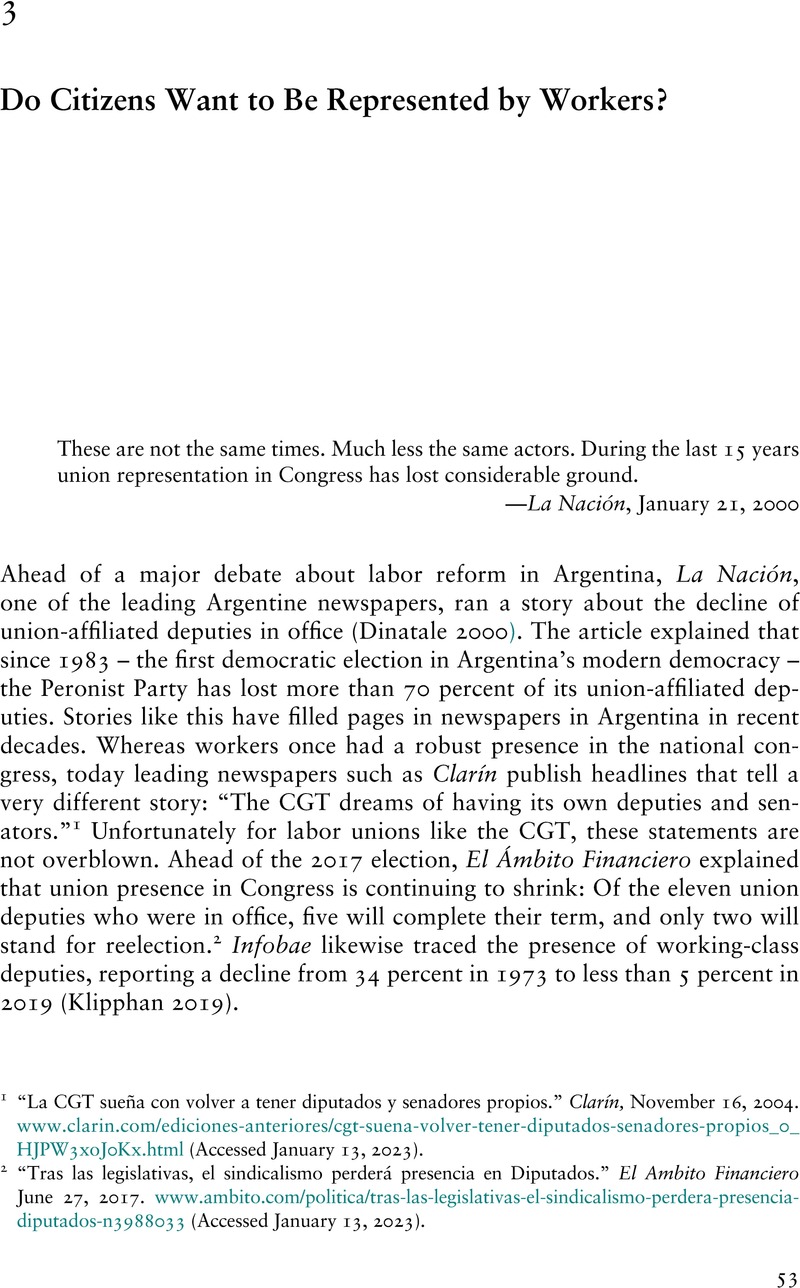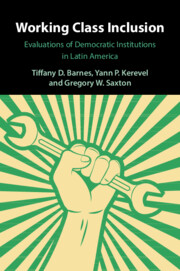Book contents
- Working Class Inclusion
- Working Class Inclusion
- Copyright page
- Contents
- Figures
- Tables
- Acknowledgments
- 1 Introduction
- 2 A Theory of Working-Class Inclusion
- 3 Do Citizens Want to Be Represented by Workers?
- 3.1 An “Ideal” Working-Class Legislature
- 3.2 Working-Class Legislators and Evaluations of Representative Institutions
- 3.3 Working-Class Legislators and Perceptions of Representation
- 3.4 Working-Class Legislators and Evaluations of Representative Institutions: Multivariate Analysis
- 3.5 Opinions of Marginalized Citizens
- 3.6 Conclusion
- Appendix 3.1 List of Countries and Survey Waves Included
- Appendix 3.2 Individual-Level Survey Questions from LAPOP
- Appendix 3.3 Coding Rules for Legislators’ Social Class – PELA Occupational Categories
- Appendix 3.4 Working-Class Representation and Evaluations of Political Institutions, Bivariate
- Appendix 3.5 Descriptive Statistics – Leftist Parties and Percent Workers in the Legislature
- Appendix 3.6 Working-Class Representation and Evaluations of Political Institutions, Multivariate
- Appendix 3.7 Working-Class Representation and Evaluations of Political Institutions, Additional Robustness Checks
- Appendix 3.8 Working-Class Representation and Evaluations of Political Institutions by Sex, Race, and Ethnicity
- Appendix 3.9 Challenges with Identifying Working-Class Citizens
- 4 Will Any Worker Do? The Role of Policy in Linking Workers’ Presence to Evaluations of Representatives
- 5 Will Any Worker Do? Linking Parties to Workers in Argentina and Mexico
- 6 How Do Citizens Know Workers Are in Office?
- 7 How Do Citizens Know Workers Are in Office?
- 8 Conclusion
- References
- Index
Appendix 3.7 - Working-Class Representation and Evaluations of Political Institutions, Additional Robustness Checks
from 3 - Do Citizens Want to Be Represented by Workers?
Published online by Cambridge University Press: 26 October 2023
- Working Class Inclusion
- Working Class Inclusion
- Copyright page
- Contents
- Figures
- Tables
- Acknowledgments
- 1 Introduction
- 2 A Theory of Working-Class Inclusion
- 3 Do Citizens Want to Be Represented by Workers?
- 3.1 An “Ideal” Working-Class Legislature
- 3.2 Working-Class Legislators and Evaluations of Representative Institutions
- 3.3 Working-Class Legislators and Perceptions of Representation
- 3.4 Working-Class Legislators and Evaluations of Representative Institutions: Multivariate Analysis
- 3.5 Opinions of Marginalized Citizens
- 3.6 Conclusion
- Appendix 3.1 List of Countries and Survey Waves Included
- Appendix 3.2 Individual-Level Survey Questions from LAPOP
- Appendix 3.3 Coding Rules for Legislators’ Social Class – PELA Occupational Categories
- Appendix 3.4 Working-Class Representation and Evaluations of Political Institutions, Bivariate
- Appendix 3.5 Descriptive Statistics – Leftist Parties and Percent Workers in the Legislature
- Appendix 3.6 Working-Class Representation and Evaluations of Political Institutions, Multivariate
- Appendix 3.7 Working-Class Representation and Evaluations of Political Institutions, Additional Robustness Checks
- Appendix 3.8 Working-Class Representation and Evaluations of Political Institutions by Sex, Race, and Ethnicity
- Appendix 3.9 Challenges with Identifying Working-Class Citizens
- 4 Will Any Worker Do? The Role of Policy in Linking Workers’ Presence to Evaluations of Representatives
- 5 Will Any Worker Do? Linking Parties to Workers in Argentina and Mexico
- 6 How Do Citizens Know Workers Are in Office?
- 7 How Do Citizens Know Workers Are in Office?
- 8 Conclusion
- References
- Index
Summary

- Type
- Chapter
- Information
- Working Class InclusionEvaluations of Democratic Institutions in Latin America, pp. 88Publisher: Cambridge University PressPrint publication year: 2023

